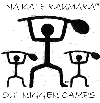
THE HANA HOU SERIES Hyperthermia © 1999 Kawika Sands |

THE HANA HOU SERIES Hyperthermia © 1999 Kawika Sands |
|
Three things determine a hot day: Temperature, humidity and wind speed. When
the Temperature approaches 90 degrees, the humidity approaches 90%, with
little wind, there is the danger of heatstroke or heat exhaustion.
Hyperthermia is a sudden and uncontrolled rise in body Temperature caused by
the inability of the Temperature-regulating cells in the brain to increase
the body's mechanisms of dissipating heat. The greater the degree of
dehydration, the more likely heatstroke will develop. The harder you
exercise, the less dehydration you can tolerate.
Dehydration decreases blood volume to the point where there's not enough blood for both the skin and internal organs, including the brain. The body must make a choice and it chooses the organs and muscles so the blood to the skin is shut off and the body Temperature rises uncontrolled.
HEAT STROKE
HEATSTROKE SYMPTOMS Respirations usually increase, but blood pressure is seldom affected. Disorientation may briefly precede unconsciousness or convulsions. The temperature climbs rapidly to 41°C and the patient feels as if they are burning up. Circulatory collapse may precede death, after hours of extreme hyperpyrexia, survivors are likely to have permanent brain damage. Advanced age, debility, or alcoholism worsens the prognosis.
HEAT STROKE FIRST-AID Remove the victim to a cooler location, out of the sun. Loosen or remove clothing and immerse victim in very cool water if possible. If immersion isn't possible, put the victim in the shock position with his head down and feet up (this will help supply the brain with blood). Pour cool water over the body and fan for quick evaporation and lower body Temperature while rubbing the skin to help open blood vessels in the skin; or use cold compresses-especially to the head & neck area, also to armpits and groin. Stop if the victim is awake, alert and out of pain. If you drop his temperature TOO quickly you can kill him. Do NOT use an alcohol rub and do NOT give any medication to lower fever, it will not be effective and may cause further harm. It is not advisable to give the victim anything by mouth (even water) until the condition has been stabilized. Once the victim's condition has stabilized, encourage the victim to drink large amounts of fruit juices and other potassium-rich drinks. Continue to watch the victim for at least an hour. If he becomes unconscious again or starts to complain of headache, nausea or dizziness, repeat the treatment (this means his Temperature is rising again). Recovery depends on heat duration and intensity. Seek medical attention immediately, and continue first aid to lower Temperature until medical help takes over. The victim should be taken to a hospital as soon as possible after the emergency methods have been started for further management. Temperature should be taken every 10 minutes and not allowed to fall below 38°C to avoid converting hyperthermia to hypothermia. Bed rest is desirable for a few days after severe heatstroke, and temperature lability may be expected for weeks.
HEAT EXHAUSTION Usually heat exhaustion is not an emergency condition but it's presence makes you more susceptible to heatstroke. Simply drink large amounts of water and mineral-rich fluid like fruit juice. Well trained athletes can function well on lower fluid levels because their hearts pump blood more efficiently. Simple dehydration takes place when an athlete sweats heavily. If he doesn't replace his fluids he can develop heat exhaustion in a few hours.
HEAT EXHAUSTION SYMPTOMS
HEAT EXHAUSTION FIRST-AID Treatment is aimed at restoring normal blood volume and improving brain perfusion, thus the patient should be placed flat or with their head slightly down. When they start responding, small amounts of sugar water may be given.
HEAT CRAMPS
HEAT CRAMP FIRST-AID
|

Last Modified: Saturday - 19991113.09:37 EST
Copyright © 1999 Kawika Sands
Produced online by HoloHolo Internet Publishing all rights reserved